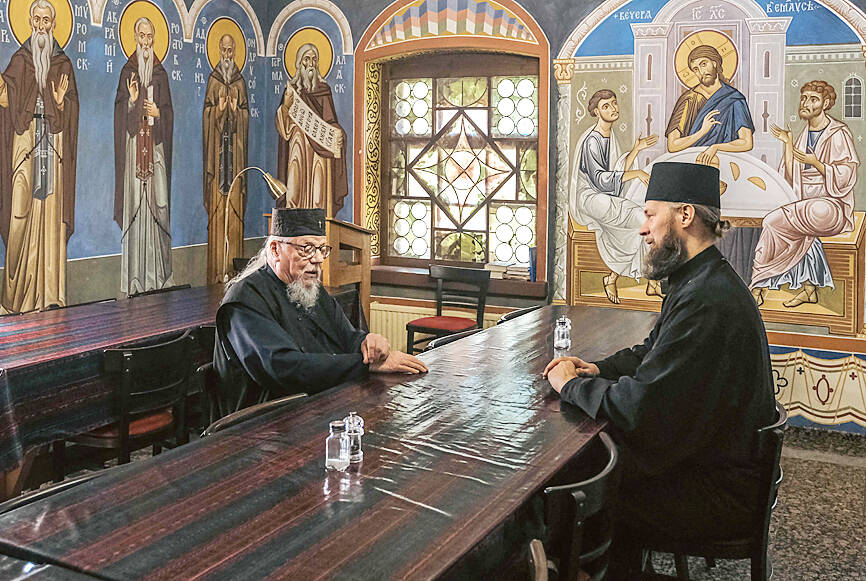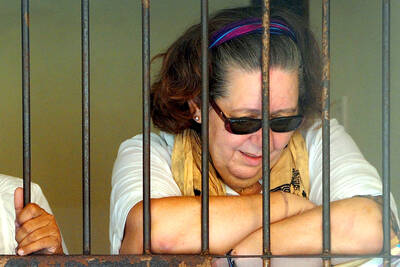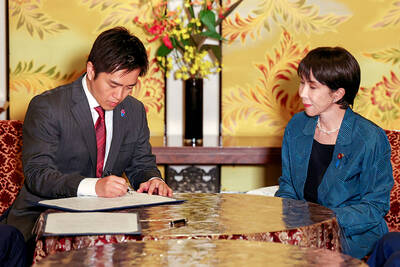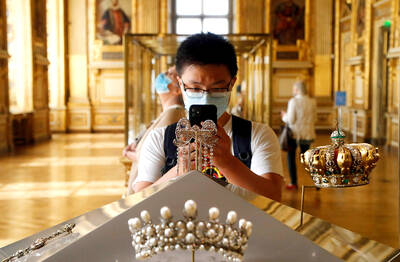Early starts, strict routines and discipline: more and more young men in Finland are being drawn to the rigors of monastic life and its conservative values.
In such a secular and progressive country, where experts had expected the young to be less religious, Christianity has been gaining ground — among young men at least.
Inside the dazzling white Valamo monastery, the country’s only Eastern Orthodox abbey, the day begins at 6am with prayers, followed by breakfast and chores. Life here is much as it has been for hundreds of years.

Photo: AFP
However, despite the spartan life, the brotherhood has been growing fast, expanding from about 10 monks to 18 in a few years.
COVID-19 was a turning point, Archimandrite Father Michael said.
“After that, we started to see a huge increase in interest,” he said.
He regularly receives e-mails from young men who want to discuss the faith and, occasionally, wish to become a novice.
“I think it is maybe the quite uncertain times we are living in. People want to have something steady, something to stand on,” he said.
The number of Finns identifying as Christian has been declining for decades. However, researchers began noticing a rise in young men’s interest in religion about five years ago.
“I was at first very skeptical of the phenomenon,” said Kati Tervo Niemela, professor of practical theology at the University of Eastern Finland.
“But the same results have been repeated over and over again in the survey data,” she said.
Inside an old wooden church adorned with icons, Father Stefanos, who was raised in an Orthodox family, said he “had always just known” he would become a monk.
“It has been great,” the 23-year-old said, taking away “all those earthly stresses people have.”
He was a student living on his own for the first time when he embarked on the monastic path two years ago — worrying about student debt and finding his place in life.
“Then the war in Ukraine started, which brought in more stuff on top of all of that,” he said.
About 63 percent of Finns are Evangelical Lutherans, with only 1 percent belonging to the Orthodox Church, the country’s second-largest national church, which is under the authority of the Patriarch of Constantinople in Istanbul. Although it traces its origins to Russia, Valamo monastery cut its ties to Moscow when Finland became an independent nation in 1917.
Tervo Niemela said some young men find deeply traditional religious groups like the Orthodox Church match their conservative values. The Orthodox Church does not, for example, allow female priests.
Young men’s opposition to some Lutheran ministers blessing same-sex marriage showed in surveys, she said.
Some young men also cited Canadian traditionalist pundit Jordan Peterson as an inspirational figure.
“Young men may find that Christianity supports them as men in a society where they feel that masculinity in general is not valued,” she said.
Meanwhile, young women in Finland — a pioneer in gender equality — continue to espouse more liberal values, Tervo Niemela added.
“We have many more men expecting women to conform to a traditional female role than women wanting to be in that role,” she said.
Dressed in a black cassock, his long hair tied in a knot, 29-year-old Deacon Raphael said he entered Valamo monastery six years ago after completing a philosophy degree.
“I had a very conventional upbringing as a Lutheran in Finland. We went to church maybe once or twice per year ... so not particularly religious,” he said.
“The kind of answers I was looking for, the church fathers answered really well. Orthodoxy I found had the most coherent answers of the Christian churches” to the big questions, he said.
Father Raphael said he had been inspired by media personalities such as French-Canadian YouTuber Jonathan Pageau, who gives a Christian Orthodox perspective on current affairs.
The monk said he believed young men were now “more conservative than females.”
“Orthodoxy in some sense is very patriarchal and conservative,” based on tradition with a capital “T,” which is why it is so attractive, he said.

Indonesia was to sign an agreement to repatriate two British nationals, including a grandmother languishing on death row for drug-related crimes, an Indonesian government source said yesterday. “The practical arrangement will be signed today. The transfer will be done immediately after the technical side of the transfer is agreed,” the source said, identifying Lindsay Sandiford and 35-year-old Shahab Shahabadi as the people being transferred. Sandiford, a grandmother, was sentenced to death on the island of Bali in 2013 after she was convicted of trafficking drugs. Customs officers found cocaine worth an estimated US$2.14 million hidden in a false bottom in Sandiford’s suitcase when

CAUSE UNKNOWN: Weather and runway conditions were suitable for flight operations at the time of the accident, and no distress signal was sent, authorities said A cargo aircraft skidded off the runway into the sea at Hong Kong International Airport early yesterday, killing two ground crew in a patrol car, in one of the worst accidents in the airport’s 27-year history. The incident occurred at about 3:50am, when the plane is suspected to have lost control upon landing, veering off the runway and crashing through a fence, the Airport Authority Hong Kong said. The jet hit a security patrol car on the perimeter road outside the runway zone, which then fell into the water, it said in a statement. The four crew members on the plane, which

Japan’s ruling Liberal Democratic Party (LDP) and its junior partner yesterday signed a coalition deal, paving the way for Sanae Takaichi to become the nation’s first female prime minister. The 11th-hour agreement with the Japan Innovation Party (JIP) came just a day before the lower house was due to vote on Takaichi’s appointment as the fifth prime minister in as many years. If she wins, she will take office the same day. “I’m very much looking forward to working with you on efforts to make Japan’s economy stronger, and to reshape Japan as a country that can be responsible for future generations,”

SEVEN-MINUTE HEIST: The masked thieves stole nine pieces of 19th-century jewelry, including a crown, which they dropped and damaged as they made their escape The hunt was on yesterday for the band of thieves who stole eight priceless royal pieces of jewelry from the Louvre Museum in the heart of Paris in broad daylight. Officials said a team of 60 investigators was working on the theory that the raid was planned and executed by an organized crime group. The heist reignited a row over a lack of security in France’s museums, with French Minister of Justice yesterday admitting to security flaws in protecting the Louvre. “What is certain is that we have failed, since people were able to park a furniture hoist in the middle of